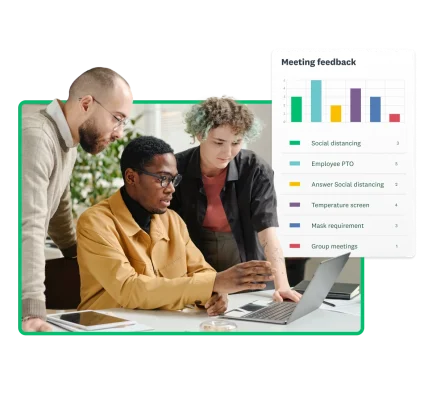12 tips on how to run an effective meeting
Run more productive meetings and support your team’s success with these tips.

Effective meetings can help organizational leaders make better business decisions, foster collaboration, and drive innovation. However, last-minute or disorganized meetings run without intention can easily waste time.
According to a recent study by Otter.ai, unnecessary meetings can cost large corporations up to $100 million annually, highlighting the need for clear meeting agendas that ensure the best use of company time.
In this guide, we will share 12 top tips on how to run an effective meeting that supports your organization’s success. Additionally, you will learn how to measure a meeting’s impact using meeting feedback surveys and other methods.
What makes a meeting effective, and why does it matter?
Effective meetings allow leaders to communicate critical business information to key stakeholders and team members. They also increase the shared knowledge of a group of individuals, helping them thrive in their jobs.
Team meetings are held for various reasons, including brainstorming, making a joint decision, sharing an initiative’s results, communicating company updates, and more. A great meeting encourages collaboration, boosts employee engagement, and fosters trust by allowing the sharing of ideas without fear of criticism.
Effective meetings are also crucial in:
- Supporting innovation
- Making important business decisions
- Ensuring everyone is on the same page
- Increasing the speed of communication
Meetings may be held in person, virtually, or in a hybrid setup. However, company meetings should always be well-planned and organized, regardless of location. Read on for 12 tips on running effective meetings.
12 tips for how to run an effective meeting
Harvard Business Review (HBR) highlights the enormous investment companies make in annual meetings. U.S. companies spend $37 billion yearly on unnecessary meetings.
How can you best ensure your company’s meetings are beneficial? Whether a meeting is a quick team catch-up to track progress toward a goal or a strategic brainstorming session, it should follow a few ground rules.
These 12 effective meeting strategies create structured, productive, and collaborative meetings that drive business results.
Download the Meeting Feedback Survey Template
Collect valuable employee feedback and build better team meetings.
1. Prioritize the meeting agenda
One of the best tips for running effective meetings is to create and stick to a clear agenda. A well-defined agenda helps participants understand expectations, stay focused during discussions, and manage time efficiently. These bullet points serve as a roadmap to keep the meeting on track and promote productive discussions.
Let’s face it: most people are busy and would rather not spend excessive time in meetings. Following a clear agenda helps hosts maintain relevant conversations that benefit a team or organization. People may break into unproductive, minor conversations or long tangents without an agenda.
Whenever possible, send the meeting agenda in advance to give attendees ample time to prepare. Display meeting agendas on screen to guide the flow of conversation and keep attendees engaged. On-screen agendas are especially helpful for remote team meetings, where it may be harder to stay engaged virtually.
2. Be punctual, present, and device-free
Being on time and fully engaged is important when leading a team meeting. You must set the tone as a meeting host by actively leading the conversation. Ask questions to get others to share feedback or input and show that you actively listen.
Maintain eye contact, call on others, put your phone away, and focus on the people in front of you. Establish a device-free meeting policy (except for the designated note-taker). By leading by example, you encourage attendees to be actively engaged and present during a meeting. Productivity drops when meeting attendees are disengaged.
3. Promote inclusivity and encourage openness
Team members and employees should feel comfortable expressing their opinions in a meeting. To promote inclusivity, give everyone a chance to speak. Avoid interrupting others to encourage attendees to share their ideas openly with the group. Be kind and courteous to fellow meeting attendees by actively listening to what they say.
Meetings are more effective when participants feel their opinions are valued. Balanced participation is crucial in hybrid meetings to ensure all team members have equal opportunities to contribute regardless of location.
Use a round-robin technique to allow everyone to speak for an allotted time, ensuring that all voices are heard. Teams can achieve meeting objectives more efficiently when different perspectives are encouraged.
4. Prioritize solutions over blame
It’s easy to slip into placing blame on certain individuals for lackluster business results. However, effective meetings prioritize finding solutions to problems over blaming others. You can make progress by focusing on moving forward positively as a team. Dwelling on an idea that didn’t work as expected wastes valuable time.
If an initiative fails, it just means it’s time to pivot. Discuss creative ideas with your team and agree on the most effective solution. Then, craft an action plan to achieve the desired results.
5. Keep track of notes and assign tasks
Designate a notetaker to track the meeting’s discussions and follow-up tasks. You can take notes yourself, ask a meeting attendee, or use an AI notetaking assistant.
After the meeting, share the notes and next steps via email to keep your team on track. Highlight important meeting insights to remember when completing the next steps.
6. Respect the clock
Effective meetings stay within their allotted time period to maintain focus and engagement. When setting meetings, keep the meeting length appropriate for the agenda, ideally not exceeding 60 minutes.
Avoid planning excessively long meetings to prevent disengagement. Follow your meeting agenda to ensure you stay on schedule. End meetings on time to show that you respect your team’s time.
To respect the clock, refrain from chit-chatting and focus on the meeting’s goals. To stay on track, create a 'parking lot' document for off-topic ideas to acknowledge them without derailing discussions and running over.
7. Actively involve all participants for balanced participation
All attendees should be involved in the meeting. Bystanders are often disengaged and don’t reap anything from the meeting.
To actively involve all participants, consider starting the first meeting in a series with an icebreaker. Icebreakers are especially beneficial when meeting attendees may not know each other. Start with introductions and have attendees answer questions like, “What’s your favorite TV show?”
Selecting meeting participants who can contribute uniquely to the discussion can also encourage participation. Diverse perspectives and knowledge are particularly important for decision-making and brainstorming meetings.
Encourage people to open up and feel comfortable before diving into the meeting’s agenda. Once everyone has introduced themselves, it will be easier to communicate with each other.
8. Tackle unspoken topics
Unspoken topics, or “undiscussables” as Harvard Business Review calls them, are “too obscured or feel too challenging to surface and discuss.” These topics could cover anything, from the quality of a new product, the tension between teams, to even a disconnect between company values and actions.
Whatever the undiscussable topic, it is worth tackling. Avoiding them can strain work relationships and cause distrust among employees. They can also harm productivity, innovation, and problem-solving efforts.
To tackle unspoken topics, address the elephant in the room sensitively but directly. Manage your response to difficult information shared to encourage honesty among your team.
9. Cultivate a positive atmosphere
To cultivate a positive atmosphere, start with your attitude as a leader. Conduct an attitude check before a meeting to ensure you come in with a positive mindset.
Be ready to lead participants in discussing important topics in your organization positively. Check any anger or frustration at the door and enter the meeting with a fresh outlook.
By making the space welcoming for participants, you can be more productive and support better meeting outcomes. Positive atmospheres help build trust and rapport among attendees.

10. Adapt to virtual and hybrid meeting needs
Video meetings have become the most common form of gathering, highlighting their importance in effective business communication, especially in hybrid and remote workplaces.
Today’s workplaces must adapt to the needs of virtual meetings. Organizations with remote workers should offer to host video conferencing calls using platforms like Zoom or Google Meet.
Virtual teams may find it more challenging to connect than in-person teams. To solve this, leaders should consider how to best share information. Deploy a remote work engagement survey or pulse surveys regularly to understand how your remote workers feel about attending virtual meetings.
Additionally, plan for distractions during virtual or hybrid meetings. Employees working from home may often be interrupted by children, pets, spouses, or technological glitches.
11. Define roles clearly
When conducting a meeting, define key roles, such as leader, facilitator, notetaker, and chat moderator (for virtual meetings).
- The leader: Team leaders play a crucial role in running effective meetings by providing updates about their departments or projects and ensuring all stakeholders are engaged.
- The facilitator: This person keeps the discussion on track and ensures the meeting follows the agenda.
- The notetaker: The team member documents key takeaways and next steps and compiles notes for a meeting summary.
- The chat moderator: Add a moderator who monitors the virtual meeting’s chat and reads out people’s questions and comments.
12. Follow-up post-meeting
A successful meeting doesn’t end when the conversation concludes. It’s best practice to send a follow-up email after the meeting summarizing the discussion. The leader should use the notetaker’s documentation to send the follow-up.
Meeting attendees and other stakeholders should receive a summary of the topics discussed, tasks assigned, and next steps. This post-meeting summary helps hold participants accountable for their next steps and action items.
Measuring meeting impact
How do you measure meeting impact? The cost of unproductive meetings is astonishingly high. Research shows that eliminating unnecessary meetings could save a company of 100 employees $2.5 million annually.
Unproductive meetings waste company time, money, and resources. That’s why it is vital for company leaders to measure meeting impact with these methods:
Attendee engagement
Leaders can use several methods to measure attendee engagement, such as tracking attendance, conducting surveys or polls, evaluating interactions between presenters and attendees, and observing body language.
- Tracking attendance: Record the attendance rate of your meetings to measure their impact on your organization. The higher the number of attendees critical to the discussion, the more significant the impact.
- Conducting surveys or polls: Sending surveys is a fantastic measure of meeting impact. Send surveys before meetings, during meetings, or as a follow-up post-meeting. Additionally, conduct live polls during meetings to encourage and monitor attendee engagement levels. Browse the SurveyMonkey template gallery for 400+ survey templates written by experts.
- Evaluating interactions: Pay attention to interactions between the presenters and attendees to see how many actively contribute to the conversation.
- Observing body language: Body language is a key indicator of whether attendees engage with the meeting. Nonverbal cues are particularly indicative of active listening.
Actionable outcomes
To measure the impact of meetings, focus on actionable outcomes, such as plans that support meeting objectives. Action items represent progress toward the meeting’s goal, so assigning action items to multiple attendees is a sign of impact.
Project planning is crucial for achieving objectives and facilitating decision-making. Collaborative meetings are particularly effective for project planning as they help with decision-making, problem-solving, and goal-setting.
Actionable outcomes also represent agreement among participants. Another sign of an effective meeting is that the team agrees on the next steps to meet the goals set. Building a cohesive team through strong communication and effective meetings supports business growth.
Time efficiency
Time efficiency demonstrates strong leadership and communication. A meeting was highly effective if your teams met the objectives and it went under time. Measure how time-efficient a meeting is by tracking the time spent versus the actionable outcomes.
Alignment with objectives
Like time efficiency, alignment with objectives strongly indicates success and impact. Was the team able to check off everything on the meeting agenda? Did you meet your goals for the specific conversation? If so, the meeting was impactful.
Assign action items and next steps to continue progressing toward the overarching goal. Alignment with objectives also signals that people were attentive and contributed to the conversation.

Follow-up and implementation
Other ways to measure a meeting’s impact are to follow up and implement action items. Monitor when your team completes action items and whether you promptly implement the meeting’s objectives. Proper follow-up ensures that participants are well-informed of their next steps.
Post-meeting surveys
Send a meeting feedback survey to allow attendees to express their opinions. The survey collects data on what participants liked and didn’t like. By collecting direct feedback from attendees, you can improve how you run meetings and gain valuable insights into areas for improvement.
One-on-one check-ins
Leadership can assess meeting effectiveness and impact in one-on-one check-ins with employees. Ask employees specific questions about how your organization runs meetings and if they have suggestions for improvement. One-on-one meetings help you gather valuable insights in a more personal setting.
Quantitative tools
Use quantitative tools to measure attendance rates, assigned task completion rates, time spent, and project milestones. These metrics are accurate ways to measure the impactfulness of your meetings. This data will also help you update your meetings to improve them continuously. Learn what’s currently working and what needs adjustment by analyzing quantitative data.
Hold effective meetings with SurveyMonkey
Meetings can be highly effective means of quickly dispersing information, making decisions, and working toward company goals. However, HR leaders must recognize the aspects of an effective meeting.
SurveyMonkey for HR professionals empowers leaders to run better meetings and reach their goals faster. Leaders can optimize meetings with our Meeting Feedback Survey Template and many other survey templates. The SurveyMonkey Zoom Integration helps organizations get more value from virtual meetings. Sign up today to experience the difference SurveyMonkey can make in your organization.
Discover more resources

HR toolkit: Make employee experience your competitive advantage
HR leaders can use this toolkit to help drive exceptional employee experiences.

State of Surveys: Top trends and best practices for 2025
Watch this webinar to explore 2025 survey trends, mobile insights, and best practices for optimizing your survey strategy.

How Americans feel about the Costco DEI policy: 25+ stats and 10 tips
68% of Americans back Costco’s DEI commitment. Explore 25+ stats on public sentiment around Costco, DEI policies, and the anti-DEI movement.

How to get more out of your employee engagement surveys
Learn how to design, analyze, and apply employee engagement surveys to drive meaningful change and improve workplace culture.